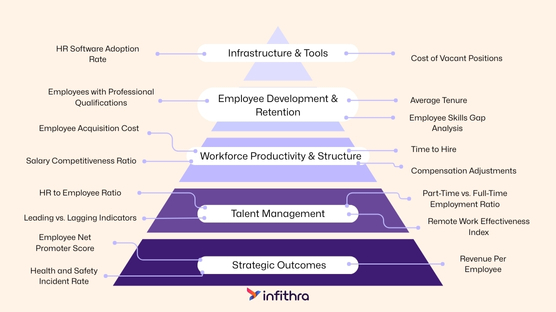Picture this: a fast-growing company in Dubai has just expanded into new markets. The team is ambitious, the strategy is solid, and the talent pool looks impressive on paper. Yet, despite the momentum, challenges begin to surface – high turnover, skills mismatches, and disengaged employees. Leaders are left wondering: where did we go wrong?
The truth is, success in today’s UAE business landscape isn’t just about hiring top talent or offering competitive salaries. It’s about understanding the heartbeat of your workforce through data-driven HR practices. Metrics give leaders the visibility they need to spot patterns, anticipate challenges, and make smarter decisions that directly influence productivity, innovation, and retention.
In fact, a 2020 survey revealed that over 54% of companies in the UAE already have a formal HR technology strategy, showing just how critical workforce insights have become. Add to that the proven link between employee development and retention, and it’s clear: the organizations that thrive will be those that measure what matters.
In this blog, we’ll explore 25 essential HR metrics every UAE business should track – tools designed not just to monitor performance, but to empower your workforce and future-proof your growth.
Importance of Data-driven HR
Behind every successful organization in the UAE is a workforce that’s not just managed, but truly understood. And understanding employees today goes far beyond intuition – it’s about harnessing data to guide decisions that shape the future of work.
Data-driven HR isn’t just a trend; it’s becoming the backbone of effective people management, operational efficiency, and business growth. Imagine knowing exactly which roles drive the most impact, what keeps your employees engaged, and where future skill gaps might emerge. With HR analytics, leaders gain this clarity, turning guesswork into strategy.
The results speak for themselves: companies with highly engaged employees consistently outperform their peers by 147%. Beyond financial performance, organizations that embrace analytics can design training and development programs that directly address gaps, empowering employees to grow while ensuring talent strategies are aligned with long-term business goals.
In short, data turns HR from a support function into a strategic driver of success. This is particularly significant in the UAE, where ongoing diversification, Emiratization programs, and digital transformation are redefining the future of work.
Here are 25 essential HR metrics every business needs to track:

1. Employee Turnover Rate
Employee turnover measures the rate at which employees leave the organization over a specific period of time. Tracking this metric helps UAE companies identify patterns, address retention challenges and maintain a stable workforce. According to a 2021 report, UAE businesses face an average turnover rate of 17% annually, highlighting the importance of effective HR metrics and retention strategies.
2. Employee Absenteeism
Absenteeism is the rate at which employees miss working days. In UAE businesses, monitoring absenteeism through attendance tracking systems helps identify potential disengagement or workplace challenges that impact overall productivity. Using attendance management software allows HR teams to regularly analyze patterns, support employee wellness initiatives and improve employee attendance.
3. Workforce Diversity
Workforce diversity tracks demographic distributions across gender, age, and region. Monitoring this metric is crucial for UAE companies to support inclusive workplace initiatives, attract a diverse talent pool and comply with regional employment goals inclusing Emiratization and gender equity programs.
4. Employee Count
Employee headcount refers to the total number of active employees in an organization at a given time. Tracking employee headcount helps manage growth effectively and ensures that HR and recruitment goals are aligned with business needs, particularly as the UAE market continues to expand.
5. Employee Retention Rate
Retention rate measures the percentage of employees who stay with the company over a specific period of time. High retention rates often reflect effective employee engagement, career development and workforce management strategies. Any workforce focusing on retention typically reduces turnover costs and builds a more stable workforce.
6. Cost Per Hire (CPH)
This metric calculates the average cost involved in hiring new employees, covering expenses such as advertising and onboarding. In industries or regions where competition for talent is strong, optimizing cost per hire helps organizations reduce expenses like travel allowance, relocation assistance, training and development, while still attracting top-quality talent.
7. HR Cost Per Employee
HR cost per employee refers to the total cost of human resource activities – such as recruitment, training, benefits administration, payroll, and employee relations – divided by the number of employees in the organization. It is calculated to assess the efficiency of HR operations and to identify areas where cost savings can be achieved. Lowering this cost improves budget efficiency, particularly in the UAE, where it is crucial for effectively managing workforce expenses across both international and local hires.
8. HR Tech ROI
The return on investment (ROI) for HR technology assesses its effectiveness in supporting HR functions. In the UAE, where HR tech adoption is rising, tracking ROI justifies expenditures and ensures alignment with evolving, technology-driven HR models.
9. HR Software Adoption Rate
HR system adoption rate gauges the percentage of employees actively using HR technology. A higher rate indicates a well-integrated HR system. In rapidly evolving tech markets, especially within the UAE, promoting user-friendly platforms is vital to ensure employees fully benefit from digital HR solutions. Notably, a survey revealed that 41.75% of organizations in the UAE are currently using Artificial Intelligence in their HR processes, indicating a growing commitment to integrating advanced HR technologies.
10. Employees with Professional Qualifications
Tracking the number of professionally certified employees provides insight into the organization’s expertise level. This metric is vital to ensuring employee competence aligns with industry standards and supports professional development goals.
11. Employee Satisfaction
Employee satisfaction measures overall job satisfaction and engagement levels. Companies with high employee satisfaction scores tend to see improved retention and productivity, fostering a positive and committed workplace culture.
12. Employee Acquisition Cost
This is the total cost to acquire new talent, considering recruitment and onboarding expenses. Reducing acquisition costs is crucial for businesses, where skilled talent is highly sought after and hiring competition is intense.
13. Compensation Adjustments
Tracking compensation changes ensures that pay adjustments remain competitive and equitable. Examples include base salary adjustments, bonuses, equity options, benefits enhancements and overtime or shift differentials.
Organizations use this metric to ensure their pay structures are competitive with market standards, to retain top talent while staying within budget.
14. Leading vs. Lagging Indicators
This metric distinguishes proactive (leading) vs. reactive (lagging) HR indicators. In organizations, identifying these indicators helps HR teams anticipate issues and adjust strategies proactively, improving overall workforce management.
15. Revenue Per Employee
Revenue per employee measures total revenue divided by the workforce size, reflecting productivity. In the UAE, companies focus on maximizing this metric to maintain high productivity levels as they grow, especially in high-cost markets like the UAE.
16. Time to Hire
Time to hire measures the duration between initiating the recruitment process and successfully completing a hire. Reducing this time is crucial for companies to capture top talent quickly in competitive job markets like Saudi Arabia and the UAE.
17. Salary Competitiveness Ratio
This ratio compares an organization’s salary levels to the market average. For businesses, it’s a key metric to ensure pay remains competitive, especially as talent markets become more transparent and global salary expectations align.
18. HR to Employee Ratio
This ratio measures the number of HR staff relative to the total number of employees, indicating the level of HR support within the organization. Companies often adjust their HR-to-employee ratio to balance the level of HR support with operational efficiency. This involves aligning the number of HR employees with the organization’s specific needs, ensuring adequate support for employees while maintaining cost-effectiveness.
19. Average Tenure
Average tenure measures the average length of time employees stay with the organization. In large organizations, longer tenures are seen as a sign of employee satisfaction and commitment, contributing to the development of skilled, experienced teams.
20. Cost of Vacant Positions
This metric calculates the financial impact of unfilled job roles on the business. In companies where roles may remain vacant due to skill shortages, minimizing this cost is essential to avoid revenue loss, productivity gaps and operational slowdowns.
21. Employee Net Promoter Score (eNPS)
eNPS reflects employees’ willingness to recommend their workplace to others. A high eNPS suggests a positive workplace culture. Companies use this metric to measure employee satisfaction and refine strategies for a supportive environment.
22. Employee Skills Gap Analysis
Employee Skills Gap Analysis identifies discrepancies between current and required workforce skills. Rapid adaptation in areas like digital literacy, data analysis, and project management is essential for maintaining competitiveness in the market and fostering strategic business growth.
23. Remote Work Effectiveness Index (RWEI)
With remote work on the rise, this index evaluates the productivity, engagement and overall performance of remote employees. Companies focusing on this metric can better support work-from-home models, improving flexibility for employees across different regions.
24. Part-Time vs. Full-Time Employment Ratio
This ratio examines the balance between part-time and full-time employees. In companies where flexible employment is increasingly accepted, tracking this metric helps companies manage workforce needs and adapt to modern employment trends.
25. Health and Safety Incident Rate
This rate calculates the number of health or safety incidents per employee. A low incident rate is essential in UAE countries, where strict safety regulations are enforced, to ensure employee well-being and regulatory compliance.
Enhancing HR Strategies and Building Better Workplaces
Tracking and leveraging the right HR metrics is not just a reporting exercise; it’s a strategic tool that drives better workforce management and stronger business outcomes. By monitoring these 25 key metrics, organizations gain actionable insights to optimize recruitment, boost employee engagement, reduce turnover, and improve overall productivity.
infithra offers a comprehensive, user-friendly HR solution designed to streamline critical people and payroll processes. With features like automated payroll management, real-time analytics, and customizable reporting, infithra enables businesses to effectively monitor and improve key HR metrics. Our platform facilitates informed decision-making, so that your organization can remain agile and responsive to evolving workforce needs.
Harness the power of HR data and elevate your workplace. Experience the infithra advantage today!


Leave a Reply